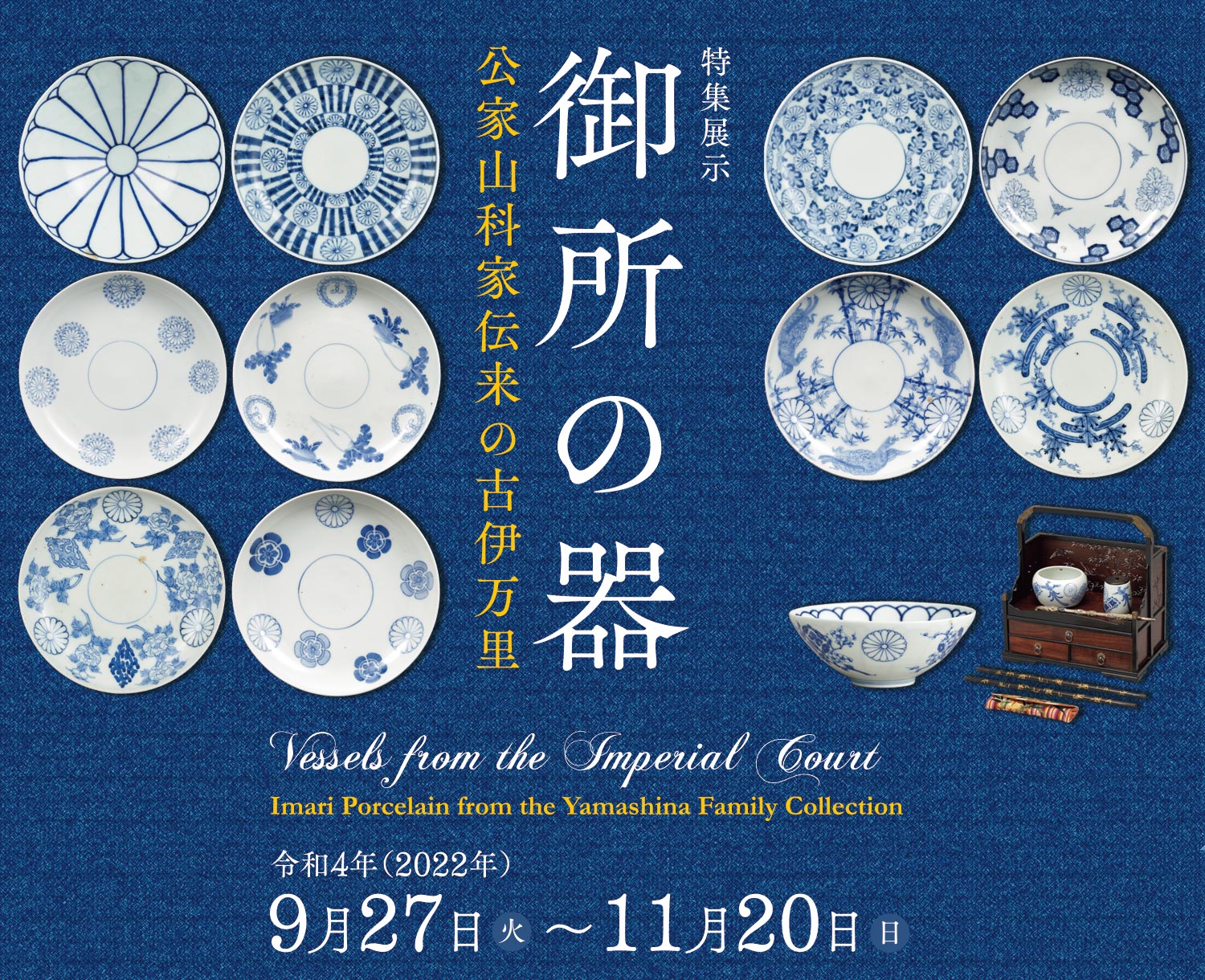

Feature Exhibition:
Vessels from the Imperial Court
Imari Porcelain from the Yamashina Family Collection
Exhibition period:
27 September – 20 November 2022
Venue:
Cultural Exchange Exhibition Hall, Room 11 and main exhibition space
Introduction:
From the Edo period onward, the Japanese imperial family began using blue-and-white porcelain produced in Arita exclusively as their tableware. These exquisite bowls and plates, decorated with the imperial chrysanthemum seal, were replaced monthly. Old crockery would be gifted to noble families, imperial priests and priestesses, and ladies-in-waiting of the court. It was through these means that the noble Yamashina family amassed a significant collection of imperial Arita ware (often called Imari ware, after the port from which they were exported to Europe). This exhibition invites viewers to view this stunning collection of once-imperial, once-noble ceramic tableware in its entirety.
Exhibition Highlights
Preface: The Yamashina Family
The Yamashina family have their origins in the Fujiwara Hokke, one of the most powerful clans in the Heian-period (8th–12th century) court. They served the emperor for many generations as Stewards of the Emperor’s Wardrobe, during which they passed down knowledge of nobles’ attire and dressing conventions—now known as Yamashina-style rules of dress. Their long-standing connection to the imperial court is believed to have been the basis upon which they received palace porcelains. Displayed in this section are a set of emperor’s robes and the diary of Yamashina Tokitsugu, considered the most important document within the Yamashina family’s collection of diaries.

Diary of Yamashina Tokitsugu
1544
Historiographical Institute, University of Tokyo
Display period: 27 Sept – 23 Oct

Diary of Yamashina Tokitsune
1598
Historiographical Institute, University of Tokyo
Display period: 25 Oct – 20 Nov

Trailing dress robe owned by Emperor Kōmei
19th century
Fukuoka City Museum
Display period: 27 Sept – 10 Oct

Dress coat owned by Empress Dowager Shōken
19th century
Fukuoka City Museum
Display period: 12 Oct – 20 Nov
Part One: Palace Porcelain from the Yamashina Collection
This section introduces sets of tableware from the palace porcelain presented to the Yamashina family. The Yamashina collection houses multiple sets of ten or more plates and bowls, which were key components of palace porcelain sets. These sets are rarely preserved on such a scale, making this collection very valuable.

Smoking set presented by Empress Dowager Shōken
19th century
Yamashina Yūsoku Research Center
Display period: Throughout

Plates decorated with imperial crest and bamboo stem motifs in underglaze blue
18th–19th century
Yamashina Yūsoku Research Center
Display period: Throughout
Part Two: Yūsoku Monyō and Palace Furnishings
Yūsoku monyō (Heian courtly motifs) are traditional designs used in the clothes, furniture, and architecture of the nobility. Many of the designs on palace porcelain combine the imperial chrysanthemum crest and yūsoku monyō. This section lifts the veil on some of the objects in the Yamashina collection by focusing on their yūsoku monyō. Feast your eyes on porcelain furnishings used in palace life, such as smoking sets, incense burners, incense cases, and braziers. This section also presents historical records from the Tsuji family, palace porcelain manufacturers who were based in Arita, Saga, as well as documents from the neighboring city of Imari, from which these porcelains were distributed.

Incense burner decorated with imperial crest, crane, and tortoiseshell motifs in underglaze blue
19th century
Yamashina Yūsoku Research Center
Display period: Throughout

Braziers decorated with imperial crest, phoenix, chrysanthemum, peony, and nadeshiko motifs in underglaze blue
19th century
Yamashina Yūsoku Research Center
Display period: Throughout
Part Three: Court Ceremonies and the Yamashina Family
The palace’s Imari porcelain was also used in ritual ceremonies both in the imperial court and within noble families. This section introduces a number of court customs documented in the Illustrated Records of Court Ceremonies, as well as the historical documents owned by the Yamashina family, who were involved in such ceremonies.

Illustrated Records of Court Ceremonies, vol. 29
1897
Tokyo National Museum
Display period: 27 Sept – 23 Oct

Illustrated Records of Court Ceremonies, vol. 39
1897
Tokyo National Museum
Display period: 25 Oct – 20 Nov

Service Memo for the Daishōji no Omono Ceremony of 1861
1861
Yamashina Yūsoku Research Center
Display period: 27 Sept – 23 Oct